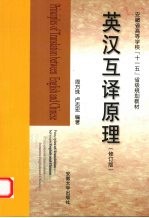

英汉互译原理PDF电子书下载
- 电子书积分:12 积分如何计算积分?
- 作 者:周方珠,卢志安编著
- 出 版 社:合肥:安徽大学出版社
- 出版年份:2008
- ISBN:9787810525091
- 页数:312 页
Chapter One Introduction 1
1.1 Definition 1
1.2 Qualification 3
1.3 Criteria of Translation 6
Chapter Two Strategies and Methods 13
2.1 Strategies 13
2.1.1 Domestication 13
2.1.2 Foreignization 15
2.2 Methods and Techniques 19
2.2.1 Literal Translation vs Free Translation 19
2.2.2 Extension 25
2.2.3 Conversion 30
2.2.4 Amplification 36
2.2.5 Simplification 43
2.2.6 Negation and Affirmation in Translation 48
2.2.7 Shift Between the Concrete and the Abstract 56
2.3 Dictionary and Translation 59
Chapter Three Translation of Words 65
3.1 Semantic Change 65
3.1.1 Broadening 65
3.1.2 Narrowing 65
3.1.3 Melioration 66
3.1.4 Deterioration 66
3.1.5 Antonomasia 67
3.2 Gaps in Translation 68
3.2.1 Lexical Gap 69
3.2.2 Semantic Gap 71
3.3 Context of Situation and Word Selection 75
3.3.1 Semantic Radiation 75
3.3.2 Direct Context and Word Selection 76
3.3.3 Indirect Context and Word Selection 78
3.4 Synonyms and Choice of Words 82
3.4.1 Synonyms 82
3.4.2 Choice of Words 85
3.5 Levels of Formality of Words and Diction 89
3.5.1 Semantic Overlap and Classification of Levels of Formality of Words 90
3.5.2 Levels of Formality and Diction 92
3.6 Proper Use of Idioms in Translation 96
3.6.1 Similarities and Diversities between Chinese and English Idioms 97
3.6.2 Corresponding Idioms 98
3.6.3 Partly Corresponding Idioms 100
3.6.4 Modifiers Are Rendered into Idioms 101
3.7 Translation of Proverbs and Two-part Allegorical Sayings 106
3.7.1 Proverbs 106
3.7.2 Two-part Allegorical Sayings 110
3.8 Translation of Allusions 113
3.8.1 Traditional Allusions 113
3.8.2 New Allusions 118
3.9 Translation of Culture-loaded Words 121
3.9.1 Similarity and Difference of Cultural Connotations between English and Chinese Culture-loaded words 122
3.9.2 Cognitive Schema Theory Applied to Translation of Culture-loaded Words 125
Chapter Four Translation of Sentences 130
4.1 Differences and Similarities between English and Chinese in Syntax 130
4.1.1 Difference and Similarity in Sentence Order 130
4.1.2 Difference and Similarity in Syntax 135
4.2 Translation of Attributive Clauses 141
4.3 Comparison and Contrast 150
4.4 Translation of Long Sentences 156
4.5 Conversion between the Passive Voice and the Active Voice 163
4.5.1 Introduction 163
4.5.2 Conversion between the Passive Voice and the Active Voice 165
Chapter Five Translation of Various Types of Writings 172
5.1 Translation of Advertisements 172
5.1.1 Lexical Level 172
5.1.2 Syntactic Level 176
5.1.3 Rhetorical Devices 178
5.2 Translation of Journalistic Texts 188
5.2.1 Definition 188
5.2.2 Classification 188
5.2.3 Stylistic Features 189
5.2.4 Major Components 192
5.2.5 Translation Strategies 196
5.3 Translation of English for Tourism 198
5.3.1 Definition 198
5.3.2 Stylistic Features 198
5.3.3 Translation Strategies 200
5.4 Translation of Scientific and Technical Writings 202
5.4.1 Linguistic Features of Scientific and Technical Writings 203
5.4.2 Increase or Decrease in Quantity 210
5.5 Translation of Diplomatic Literature 214
5.5.1 Features of Diplomatic Language 215
5.5.2 Translation of Diplomatic Literature 218
Chapter six Translation of Literary Works 224
6.1 Introduction 224
6.2 Fidelity to SLT Literary Messages 230
6.2.1 Fidelity to Semantic Information 230
6.2.2 Fidelity to Grammatical Information 231
6.2.3 Fidelity to Rhetorical Information 232
6.2.4 Fidelity to Pragmatic Information 232
6.2.5 Fidelity to Cultural Information 233
6.2.6 Fidelity to Syntactic Information 234
6.2.7 Fidelity to Aesthetic Information 235
6.3 Translation of Fiction 239
6.3.1 Introduction 239
6.3.2 Translation of Titles 240
6.3.3 The Stylistic Features Reproduced in Translation 241
6.4 Translation of Prose 245
6.5 Translation of Poetry 253
6.5.1 Opposite Opinions on Translation of Poetry 253
6.5.2 Different Opinions on Subjectivity 259
6.5.3 Translation of Poetry between English and Chinese 260
6.6 Translation of Dramatic Texts 284
6.6.1 A Performance-oriented Translation vs.A Reader-oriented Translation 284
6.6.2 Text vs.Subtext 289
Appendix 293
翻译练习参考答案 293
Bibliography 310
- 《第一性原理方法及应用》李青坤著 2019
- 《计算机组成原理解题参考 第7版》张基温 2017
- 《高等院校保险学专业系列教材 保险学原理与实务》林佳依责任编辑;(中国)牟晓伟,李彤宇 2019
- 《刑法归责原理的规范化展开》陈璇著 2019
- 《教师教育系列教材 心理学原理与应用 第2版 视频版》郑红,倪嘉波,刘亨荣编;陈冬梅责编 2020
- 《单片机原理及应用》庄友谊 2020
- 《通信电子电路原理及仿真设计》叶建芳 2019
- 《计算机组成原理 第2版》任国林 2018
- 《化工原理课程设计》刘建周主编 2018
- 《会计学原理》邵瑞庆主编 2019
- 《市政工程基础》杨岚编著 2009
- 《家畜百宝 猪、牛、羊、鸡的综合利用》山西省商业厅组织技术处编著 1959
- 《《道德经》200句》崇贤书院编著 2018
- 《高级英语阅读与听说教程》刘秀梅编著 2019
- 《计算机网络与通信基础》谢雨飞,田启川编著 2019
- 《青青校树》徐伟珠译;(捷克)兹旦内克·斯维拉克 2019
- 《看图自学吉他弹唱教程》陈飞编著 2019
- 《法语词汇认知联想记忆法》刘莲编著 2020
- 《培智学校义务教育实验教科书教师教学用书 生活适应 二年级 上》人民教育出版社,课程教材研究所,特殊教育课程教材研究中心编著 2019
- 《国家社科基金项目申报规范 技巧与案例 第3版 2020》文传浩,夏宇编著 2019
- 《大学计算机实验指导及习题解答》曹成志,宋长龙 2019
- 《大学生心理健康与人生发展》王琳责任编辑;(中国)肖宇 2019
- 《大学英语四级考试全真试题 标准模拟 四级》汪开虎主编 2012
- 《大学英语教学的跨文化交际视角研究与创新发展》许丽云,刘枫,尚利明著 2020
- 《复旦大学新闻学院教授学术丛书 新闻实务随想录》刘海贵 2019
- 《大学英语综合教程 1》王佃春,骆敏主编 2015
- 《大学物理简明教程 下 第2版》施卫主编 2020
- 《大学化学实验》李爱勤,侯学会主编 2016
- 《中国十大出版家》王震,贺越明著 1991
- 《近代民营出版机构的英语函授教育 以“商务、中华、开明”函授学校为个案 1915年-1946年版》丁伟 2017
